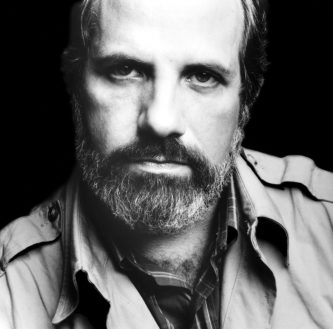 r out of Hollywood quite like Brian Russell De Palma, who recently published his first novel, the delirious pulp thriller ARE SNAKES NECESSARY? In honor of that milestone, and the fact that the critical establishment appears to finally be putting aside its decades-long ire toward this “Director You Hate to Love” (so stated an American Film magazine cover) and recognizing him for the genius he is, I’ll be taking a look back over De Palma’s fifty-plus year career via a personal ranking of his films.
r out of Hollywood quite like Brian Russell De Palma, who recently published his first novel, the delirious pulp thriller ARE SNAKES NECESSARY? In honor of that milestone, and the fact that the critical establishment appears to finally be putting aside its decades-long ire toward this “Director You Hate to Love” (so stated an American Film magazine cover) and recognizing him for the genius he is, I’ll be taking a look back over De Palma’s fifty-plus year career via a personal ranking of his films.
That career has admittedly yielded up a number of clunkers, as will be demonstrated below, but also several honest-to-goodness classics. Most of the lesser De Palma films in my view hail from the earliest days of his career, and also, unfortunately, his more recent years. Let’s hope this downturn in quality is a blip rather than a trend, and concentrate on the good stuff, starting with…
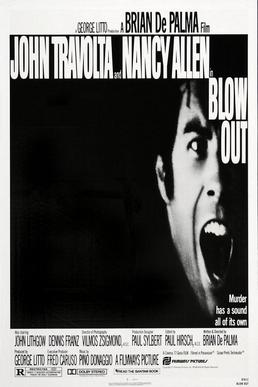 1. BLOW OUT (1981)
1. BLOW OUT (1981)
One of three early eighties masterworks by De Palma. BLOW OUT is the most humanistic and least violent film of the trio (which includes the #3 and #4 entries on this list), although it contains many signature De Palma elements. There’s a soundman played by John Travolta, caught up in a BLOW UP like drama in which he suspects he may have caught the audio of a murder while recording ambiance for a shitty horror movie. The sequence in which Travolta winds back and marks his film where he believes a gunshot occurred is among De Palma’s greatest accomplishments, being visually seductive yet appropriately methodical in a way you just don’t see in American cinema (then or now).
Other cinematic coups include the famous looping camera shot that continuously circles Travolta’s studio as he discovers that all his recordings have been erased, and the heartbreaking final confrontation atop a roof that’s set, in a curiously appropriate touch, amid a fireworks display. Travolta, it must be said, is quite fine in the lead role, with a warm yet edgy and streetwise air, and Nancy Allen (to whom De Palma was married) is his equal as the prostitute with whom Travolta’s character has the misfortune to become acquainted.
2. CARRIE (1976)
One of De Palma’s most stylish and absorbing films. CARRIE also boasts a tight script by Lawrence D. Cohen that simplifies and streamlines Stephen King’s 1974 novel quite nicely, and great performances by Sissy Spacek as the psychically endowed teenager Carrie, Piper Laurie as her psychotic mother and Nancy Allen as the school bitch queen. De Palma stages one of his best-ever sequences in the justifiably famous prom massacre, a terrifying yet intellectually stimulating melee where Carrie gets her just revenge and De Palma’s patented split screen technique reaches some kind of apotheosis. If it weren’t for a few minor but annoying miscalculations (a lame attempt at comedy in a tuxedo store and a number of laughably dated phrases/fashions/etc.) CARRIE would be an all-time classic. Maybe it is anyway.
3. SCARFACE (1983)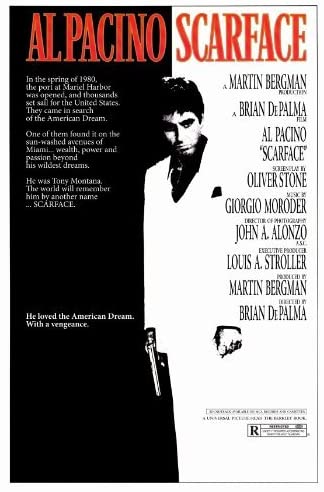
De Palma’s Miami set 1980s updating of the Pre-Code gangster movie classic remains unsurpassed for over-the-top violence, flamboyant visuals and endlessly quotable dialogue (who can forget lines like “This town’s like one big pussy just waiting to be fucked”…?) Plus it features Al Pacino in one of the most memorable performances of all time; it’s literally impossible not to imitate him after viewing SCARFACE. Oliver Stone’s script is an audacious mixture of political table thumping (with digs at Fidel Castro and US foreign policy) and bloody action, while De Palma is as always bold and unflinching in his depiction of violence, and isn’t afraid to wade into some extremely controversial waters. And we mustn’t forget Michelle Pfeiffer, who’s nearly as memorable as Pacino in the role of one of the screen’s most alluring ice queens.
4. DRESSED TO KILL (1980)
Forget BASIC INSTINCT and FATAL ATTRACTION, as the poetic, disturbing and erotic-as-Hell DRESSED TO KILL is the “erotic thriller” to see. Angie Dickinson is simply great as the horny hausfrau whose tryst with a strange man kicks things off, and Michael Caine quite menacing as the none-too-trustworthy psychiatrist who councils her. The script is admittedly a bit implausible and derivative (complaints that, as we’ll see, tend to recur in De Palma’s filmography), but from a visual standpoint the film is a masterpiece. Every shot is executed with breathtaking precision and invention, yet the characters are always allowed to take center stage.
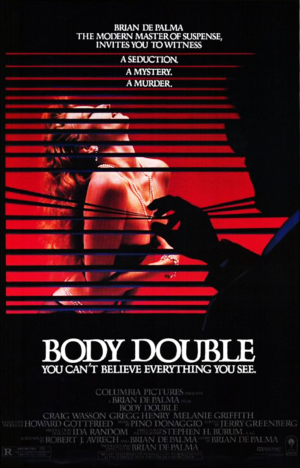 5. BODY DOUBLE (1984)
5. BODY DOUBLE (1984)
This film is quite similar in conception to DRESSED TO KILL, but features a more comedic, self-mocking angle. It features a struggling actor (Craig Wasson) accepting an offer to stay in a UFO-like art deco house, and plunging into a wild, twisty drama of perversion, voyeurism, murder and porn. De Palma seems fully aware of the ridiculousness of his material (whose absurdities include an out-of-nowhere romantic interlude and an attempted murder carried out in full view of a police roadblock) and has a good time with it—although be advised there’s a reason the title character of Brett Easton Ellis’ AMERICAN PSYCHO watches BODY DOUBLE’S infamous drill murder sequence over and over. And let’s not forget the performances: in the lead role Craig Wasson is the quintessential nerdy eighties actor, and Melanie Griffith delivers the finest performance of her career as a cute and sassy porn star, who despite only a half hour or so of screen time all-but walks away with the picture.
6. PHANTOM OF THE PARADISE (1974)
Made before De Palma elected to concentrate on horror-suspense fare, PHANTOM OF THE PARADISE is an overtly campy send up of the glam rock scene, made with total assurance and an unerring eye for the outrageous. Paul Williams plays Swan, a corrupt record mogul who’s sold his soul to the Devil, while William Finley is Winslow Leach, a wannabe musician turned caped phantom who terrorizes Swan’s nightclub after the latter rips off his music, and Jessica Harper makes a memorable debut as the sweet young thing lusted after by both men. The film is great fun to watch, with wild, swooping camerawork, a bold color scheme and a virtuosic early example of De Palma’s patented split-screen technique. Plus the songs, penned by Williams, are rocking.
7. CASUALTIES OF WAR (1989)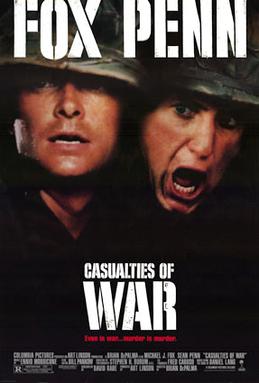
A really, really good film that falls just sort of being great. It’s a brutal and uncompromising look at the true-life rape and murder of a Vietnamese girl by a US Army platoon back in ‘69, as related in Daniel Lang’s similarly titled book. In the lexicon of eighties ‘Nam movies CASUALTIES OF WAR lacks the gritty realism of PLATOON and HAMBURGER HILL. With its unabashed melodrama, it’s more like a Samuel Fuller movie, and like Fuller, De Palma isn’t hesitant about laying the sap on thick—and it works. The camerawork is impeccable, the performances are great and the Vietnamese girl’s mid film death walk remains a profoundly haunting bit of cinema. If the film had continued in that vein it would be a masterpiece, but De Palma wimps out in the end, having his protagonist (Michael J. Fox) somehow absolved of guilt for his wartime actions by the sight of a Vietnamese college student who looks like the murdered girl (and was in fact played by the same actress).
8. SISTERS
SISTERS was De Palma’s seventh feature, and his first notable success. Margot Kidder plays a model who meets a dashing young man on a game show, and lures him back to her apartment. The following morning the man is stabbed to death, apparently by Danielle’s deranged twin sister. The killing is witnessed from an adjacent apartment by a muckraking reporter (Jennifer Salt) who becomes determined to take Kidder down for the killing. Eventually Salt winds up captured and drugged, in which state she hallucinates that she’s Kidder’s twin! In many respects SISTERS serves as a dry run for DRESSED TO KILL, which closely replicates its overall structure. That structure, of course, is borrowed rather blatantly from PSYCHO, yet De Palma adds a wealth of bizarre and imaginative touches. The voyeuristic game show of the opening scene begins the film on a psychologically unsettling note entirely appropriate to the subject matter, while the red and white color scheme of the protagonist’s apartment building is arrestingly weird. There’s also an early sequence that must be counted as one of the finest-ever uses of a split screen, at once a startling cinematic innovation and an example of narrative ingenuity that doesn’t feel gratuitous or show-offy.
 9. THE UNTOUCHABLES (1987)
9. THE UNTOUCHABLES (1987)
This David Mamet scripted commercialization of the Eliot Ness saga no longer packs the wallop it once did (for me, at least), but remains a highly enjoyable, ultra-violent trifle. Kevin Costner is adequate as Eliot Ness and Sean Connery quite endearing as his tough right hand man, while Robert De Niro is simply unforgettable as Al Capone. The scene where he bashes in a confidante’s head with a baseball bat is still an ass-kicker, and I’ve never stopped quoting Mamet’s dialogue (Q: “What are you gonna do when they repeal prohibition?” A: “Have a drink!”).
10. MISSION: IMPOSSIBLE (1996)
Silly popcorn fun, and make no mistake: it IS fun. MISSION: IMPOSSIBLE is a Tom Cruise vehicle from the late nineties, when Hollywood was feverishly adapting old TV shows for the screen, and served as the inception of the long-running MISSION: IMPOSSIBLE movie franchise. Unsurprisingly given its director’s pedigree, this MISSION is much darker than its follow-ups, with nearly all its principals (played by Kristin Scott Thomas, Emilio Estevez and Jon Voigt) killed off in the opening half hour, leaving Cruise to navigate the international intrigue largely on his own. This isn’t to say the film is in any way a character study. Rather, it’s an unabashed blockbuster built around two supersized set-pieces: a RIFIFI-inspired heist sequence set in a heavily fortified computer lab and the CGI-heavy train set climax, both set up and executed with a great deal of skill by De Palma. It’s a shame he didn’t pay more attention to the narrative, which is twisty and fast moving but never particularly gripping or coherent.
11. RAISING CAIN (1992)
Yet another film that could have been a classic but just doesn’t cut it. It was De Palma’s return to making a Brian De Palma movie after years of squandering his talent on commercial swill. Technique-wise RAISING CAIN is an out-and-out masterpiece, with near-unbelievably brilliant camerawork and editing. The intricate PEEPING TOM-inspired storyline is equally impressive, utilizing flashbacks, dreams and multiple viewpoints to create a structure as revolutionary in its own way as that of PULP FICTION. So what’s the problem? Think back to DRESSED TO KILL and BLOW OUT: eye-poppingly brilliant as those films were technically, both concentrated first and foremost on character. In RAISING CAIN, by contrast, the characters are little more than puppets whose sole purpose is to serve the plot, proving that, contrary to what De Palma and others like to claim, making empty-headed Hollywood productions does indeed have a detrimental impact.
12. REDACTED (2007)
This was the most controversial film of 2007, proving that De Palma, who was then in his late sixties, hadn’t lost his edge. I wouldn’t call REDACTED a complete success by any means, but it is an eye-opening experimental film of a type I thought American cinema had left behind in the seventies. It’s essentially a remake of CASUALTIES OF WAR, transferred from Vietnam to Iraq and presented through several different media formats: a French documentary, an embedded cameraman’s POV and snippets from various internet sources, all working to relate the story of the rape and murder of a fifteen-year-old Iraqi girl by American soldiers. I didn’t find the depiction of the rape (which is pretty tame) nearly as disturbing as the portrayal of American soldiers descending into madness, and how the military twists around the facts of the case until it becomes effectively “redacted.” The film suffers from clunky dialogue and bad acting, but is the only one of the many Iraq movies of the late 00s that’s worth your time, being innovative and uncompromising in its approach, not to mention unabashedly politically incorrect. In short, it’s exactly what we need.
 13. HI, MOM! (1970)
13. HI, MOM! (1970)
HI, MOM! was the sequel to GREETINGS (see below). It stars Robert De Niro, who now boasts above-the-title billing, reprising his role as an aspiring NYC filmmaker. Having returned from Vietnam (where he was sent at the conclusion of the last film), he moves into a trashy apartment building whose sole point of favor is that it affords him a generous glimpse of the neighboring building—thus providing an early example of De Palma’s favorite theme: voyeurism. All this is very much in keeping with the puddle-deep Godardian silliness of the previous film, but this one contains an attention-grabbing theatrical interlude. Filmed guerilla style in black and white, the show is put on by a black theater collective called “Be Black Baby,” in which unsuspecting white theater-goers have their faces smeared with black paint and are subjected to brutality and rape, ostensibly to experience how it is to be black. This alternately hilarious and appalling sequence is one of the most outrageous De Palma has ever staged, and powerful enough that it all-but obliterates the rest of the film.
14. FEMME FATALE (2002)
An unabashed exercise in style over substance. FEMME FATALE stars Rebecca Romijn (back when she was Rebecca Romijn-Stamos) as a hottie who double deals her way up and down Paris while fucking—and fucking over—pretty much everything that moves, in particular Antonio Banderas as a duplicitous photographer. Ms. Romijn isn’t much of an actress, but she’s not exactly called upon to do much emoting here; for that matter, the ultra-twisty narrative, complete with a RUN LOLA RUN styled climax, isn’t particularly important to De Palma’s scheme. In this film style is truly everything, from the prowling Steadicam visuals to the seductive Ryuchi Sakamoto score to De Palma’s extensive use of (you guessed it) split screens.
15. PASSION (2012)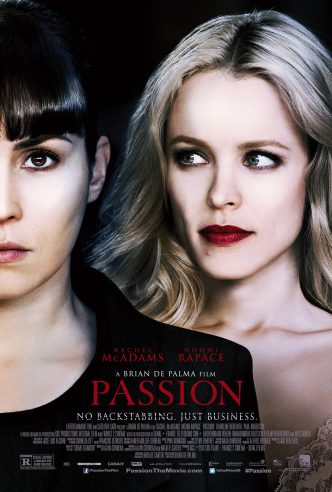
Remaking the 2010 French thriller LOVE CRIME (which I never much liked) was a rotten idea in my view, but De Palma makes a conditional success of the job. PASSION is sleek, good looking and adds some elements that weren’t in the original film, such as a strain of barely-suppressed lesbianism and a twin sister of one of the protagonists. Those protagonists are played, in a wild bit of stunt casting, by the cute and perky Rachel McAdams as an amoral businesswoman and the more brooding and introspective Noomi Rapace as a put-upon employee who decides to fight back. Much quintessentially De Palma-esque intrigue ensues, including a bloody murder, a shocking revelation and an elaborate dream sequence. All this is diverting enough, but the puzzling and inconclusive ending is downright infuriating.
16. CARLITO’S WAY (1993)
A film that, like SCARFACE before it, was largely ignored during its initial release but found new life on home video. I know this is an unpopular opinion, but I say critics and audiences got it right the first time. CARLITO’S WAY was De Palma’s attempt at recapturing the infernal magic of the former film, together with its producer Martin Bregman and star Al Pacino. The setting is NYC, where a Latino drug lord (Pacino, sporting a distractingly unconvincing accent) is attempting to go straight after being released from prison. Of course he quickly falls back into a life of crime, and leaves a lot of corpses in his wake (his own included). It’s all extremely inauthentic and Hollywood-ish, and includes a ludicrously miscast Penelope Ann Miller as Pacino’s long-suffering stripper girlfriend. Yet the film does contain some great De Palma set pieces, most notably a nail-biting elevator “hit” and the final foot chase through Manhattan’s Grand Central Terminal, which features some truly bravura camerawork.
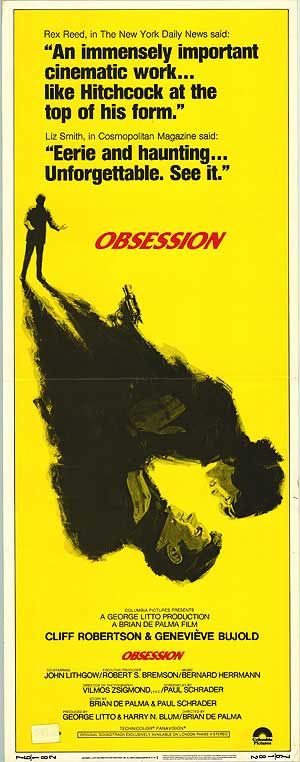 17. OBSESSION (1976)
17. OBSESSION (1976)
One of the most shameless of De Palma’s Hitchcock wannabes, a none-too-disguised riff on VERTIGO. Scripted by Paul Schrader and scored, quite bombastically, by Hitch’s favored composer Bernard Herrmann, OBSESSION has in its favor a compelling gothic atmosphere a memorably overwrought finale. Such unabashed excess is something this film really needs, as for the most part it’s unexciting, suffering from a painfully thin narrative and a climactic twist that isn’t exactly difficult to foresee—not to mention the fact, again, it’s quite derivative of a certain past movie. It features Cliff Robertson as the wealthy husband of Genevieve Bujold, who together with their young daughter dies (it seems) during a kidnapping. But years later a woman who looks just like Robertson’s deceased spouse (and is also played by Bujold) turns up during a trip to Italy, inspiring him to attempt to transform her into his ideal. But then history repeats itself in a second kidnapping, and Robertson learns some unsavory secrets about his life (the fact that his best friend is played by frequent De Palma bad guy John Lithgow is not insignificant in this regard). It’s a film, in short, that goes exactly where you’d expect it to.
18. THE FURY (1978)
A blatant attempt at replicating the success of CARRIE (and a dry run for a never-made adaptation of THE DEMOLISHED MAN), this was De Palma’s first would-be blockbuster. Unsurprisingly, THE FURY, adapted from a sprawling novel by John Farris, wasn’t the massive hit De Palma and 20th Century Fox were anticipating. It’s a highly uneven film that only works in fits and starts, with an interesting story about psychically endowed teens (Andrew Stevens and Amy Irving) abducted by a sinister government agency that suffers from an overly expansive epic canvas that only confuses matters; a more intimate treatment, like that afforded CARRIE, would have been preferable. The best parts are a couple of spectacularly gruesome psychic kills, the final exploding torso in particular—although it was outdone three years later by SCANNERS, which, furthering my overall critique of THE FURY, accomplishes a similar effect in a far simpler manner.
19. SNAKE EYES (1998)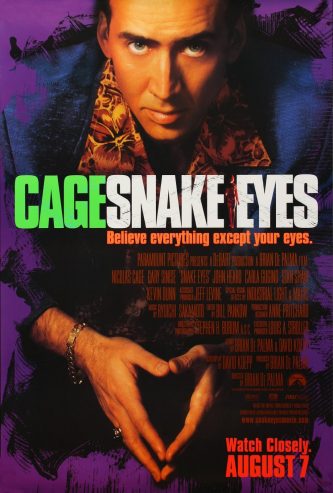
While it’s not as terrible as some would have you believe, try comparing this film with DRESSED TO KILL or BLOW OUT. De Palma’s technical virtuosity and imaginative camerawork are very much in evidence throughout SNAKE EYES, but the atmosphere, compelling characterizations and voyeuristic charge of those earlier films are nowhere to be found. Instead we’ve got a plain silly story about a political assassination and the corrupt cop (Nicholas Cage) who witnesses it. In the course of the film Cage meets a hot chick (Carla Gugino) who’s also involved in the murder, and comes to the realization that his colleague (Gary Sinise), also present at the scene of the crime, might just be behind it all. Rest assured, though, that all works itself out in the end, and that our formerly selfish hero becomes a Better Person.
20. THE BONFIRE OF THE VANITIES (1990)
One of the most notorious flops of the 1990s, this adaptation of Tom Wolfe’s vastly overrated bestseller is most interesting for what it could have been. Certainly this antic account of a wall street tycoon (Tom Hanks) igniting a media circus in the wake of a hit and run accident contains snatches of the type of biting reality-based satire De Palma appears to have been trying for, but for the most part BONFIRE OF THE VANITIES is a dreary film marked by distracting snow-offy visuals, indifferent performances (with Hanks severely miscast in a role that would have been better served by his co-star Bruce Willis, just as two of the other cast members, Melanie Griffith and Kim Cattrall, would have done well to swap their roles) and a wavering tone that De Palma evidently never quite nailed down. Of course, the famous book about the film’s production, THE DEVIL’S CANDY by Julie Salomon, places the blame for the film’s failure in the hands of the studio executives who vetted the material to death, so I guess we can’t fault De Palma too much.
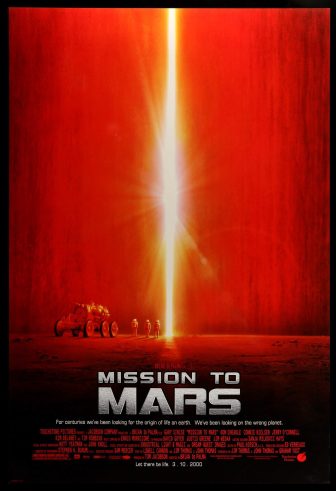 21. MISSION TO MARS (2000)
21. MISSION TO MARS (2000)
From a purely visual standpoint the mega-budgeted MISSION TO MARS, a Disney production based on the amusement park ride of the same name, is a stunner. However, it offers further proof (as if any were needed) that Hollywood screenwriters (who here include Jim Thomas, John Thomas and SPEED’s Graham Yost) have absolutely NO idea of how people actually talk, as it contains some of the clunkiest dialogue you’ll hear. But again, the visual set-pieces are GREAT, from a tango aboard a space station to the entrance to an alien craft (which quickly turns lame) to an awesome spacewalk, complete with the type of overheated melodrama for which I’m always a sucker.
22. GREETINGS (1968)
In which a young De Palma, attempting to become the “American Godard,” essentially goofed off for ninety minutes with some actor buddies, a young Robert De Niro among them. The film is an ersatz comedy filmed verite style in NYC, with De Niro and a couple other guys looking to evade the draft and get laid. The latter proclivity leads to a provocative bit in which De Niro poses as a filmmaker in order to get a woman to strip, but the scene, like so much else in this film, drags woefully and goes nowhere. There are also a series of dates one of the group goes on with various women that are supposed to be funny (I guess), and a lot of miscellaneous improvisational business. Of interest solely as a late sixties time capsule.
23. WISE GUYS (1986)
Possibly the most impersonal film De Palma has ever made, a shallow eighties comedy with virtually none of the visual bravura that tends to mark out even his crappiest films. It stars Danny De Vito and Joe Piscopo as small time mobsters who after losing several thousand dollars’ worth of their boss’s money at the racetrack are contracted to rub out each other. This leads to a succession of complications that with a director who gave a damn about what he was doing might have at least been diverting. As it is, though, WISE GUYS is merely dull and uninvolving, despite a vast overqualified supporting cast (Harvey Keitel, Dan Hedaya, Patti Lupone, etc.).
24. DOMINO (2019)
This is, unfortunately, De Palma’s latest film, and has already been written off as a major misfire (the fact that De Palma himself has all-but disowned it is certainly not encouraging). It’s a thriller that was evidently conceived in the MISSION: IMPOSSIBLE mode, about Nikolaj Coster-Waldau as a cop looking to take down a terrorist cell and Guy Pearce as the CIA agent opposing him. This was apparently part of a more wide-ranging, labyrinthine narrative that was largely jettisoned due to budgetary constrictions, leaving us with a shockingly inert and uninteresting film whose every particular all-but screams straight to video. There are, at least, some reasonably good De Palma set-pieces, including a rooftop chase and a suspenseful stadium set climax.
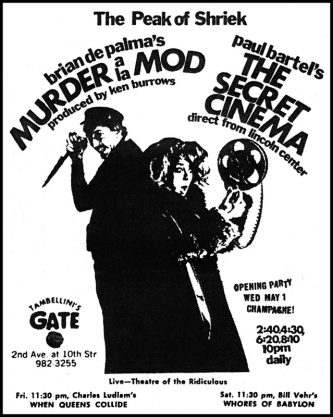 25. MURDER A LA MOD (1967)
25. MURDER A LA MOD (1967)
This early feature is interesting solely as a harbinger of things for which its young director clearly wasn’t ready. Suffused with tiresome sixties-era experimentation, it’s a would-be comedy that juxtaposes the making of a scrappy NYC porno movie with the doings of a goofy serial killer. Very much an(other) example of style over substance, and the screwball tone only further distances us from the action.
26. THE BLACK DAHLIA (2006)
A shockingly lifeless neo-noir centered on the 1947 investigation into the murder of Elizabeth Short, a.k.a. The Black Dahlia, which to this day remains unsolved. The film is based on a 1987 novel by James Ellroy, a book and author I’ve always found overrated, and De Palma only renders the material duller and more clichéd than it was to begin with. It certainly doesn’t help matters that the film’s headliners Josh Hartnett, Scarlett Johansson and Hilary Swank were all hopelessly miscast (with the best performance delivered by THE L WORD’S Mia Kirshner as the Dahlia, who appears only in brief flashbacks). Even the period art direction, while clearly achieved with painstaking effort and not a little money, feels labored and artificial. Sure, there are some impressive visual flourishes, but there should be, considering the camerawork was evidently the only element to which De Palma payed any attention.
27. DIONYSUS IN ’69 (1970)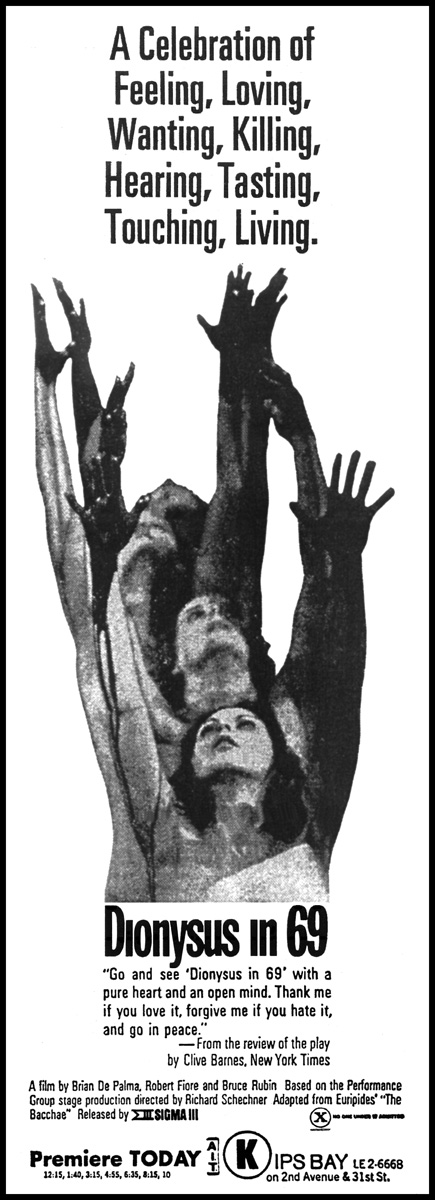
A quintessential counterculture artifact: a filming of a performance of Euripides’ THE BACCHAE, put on in a cramped auditorium by an avant-garde NYC theater group (whose ranks include future De Palma regular William Finley), that involves a lot of miscellaneous shouting and lascivious activity, with the audience members encouraged to join in. I guess you just had to be there, as I found it dull and repetitive, with the sole point of interest being the split screen treatment De Palma gives the material, showing different portions of the play occurring simultaneously. Even this, however, has its drawbacks, as unlike De Palma’s future use of split screen there doesn’t appear to be any rhyme or reason to how it’s utilized here.
28. GET TO KNOW YOUR RABBIT (1972)
De Palma’s earliest attempt at big studio moviemaking was this eminently forgettable bit of counterculture bait that despite its director’s pedigree (as an actual member of that culture) smacks of square-ness. It’s very much in the mold of “with it” Hollywood misfires like SKIDOO and ZABRISKIE POINT in its inert account of an uptight businessman (Tommy Smothers) who throws it all away to become a travelling magician. Orson Welles plays Smothers’ mentor (but doesn’t get enough screen time to make a proper impression) and Katherine Ross the hot chick love interest (likewise).
29. THE WEDDING PARTY (1966)
This nothing movie was De Palma’s first feature, and also the screen debut of Robert De Niro. It is, as the title indicates, about a wedding party at a snazzy beachfront mansion, in which the groom—one of whose pals is played by De Niro—finds himself having second thoughts amid all the pomp and opulence. Shot in black and white, the film is decked out with gratuitous visual gimmicks—slow motion, fast motion, superimposition, etc.—that do nothing to obscure the fact that very little of any consequence is occurring onscreen.
30. HOME MOVIES (1980)
Here, in what I feel is his worst-ever movie, De Palma, following up the big budget misfire of THE FURY, attempted to return to his low budget comedy roots with a scrappy product made with film students from Sarah Lawrence college. A student film is precisely what HOME MOVIES resembles, with unfunny screwball comedy and shockingly undistinguished filmmaking. As for the story, about a nerd (Keith Gordon) caught between his drama queen mother and adulterous father, it’s interesting solely for its autobiographical details (having been closely patterned on De Palma’s own adolescence). Also featured are Kirk Douglas as a famous director known only as “The Maestro,” De Palma regular Gerrit Graham as Gordon’s overachieving older brother and Nancy Allen as Graham’s flighty fiancée. There’s really no point going into the film in much more detail, as, frankly, it’s complete nonsense.
